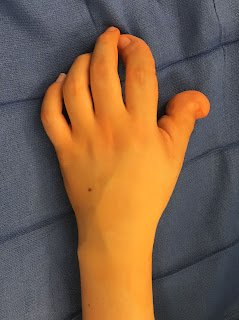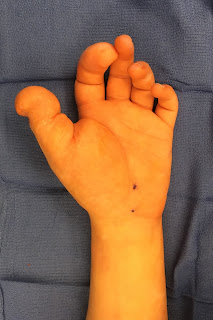Macrodactyly is an uncommon birth condition of the upper extremity. I have posted several previous times on macrodactyly:
Macrodactyly Post
Macrodactyly Post 2
Macrodactyly means ‘large finger’ and sometimes is referred to as local gigantism. My other posts have discussed different facts about the diagnosis including why this may happen but here I would like to discuss three potential surgeries for macrodactyly.
1. Local control of size and growth. It is not uncommon that this surgery is performed multiple times on a young child. The idea is to debulk the finger (primarily by removing extra fat and skin) but also potentially closing growth plate early. The appeal of this surgery is that it is straightforward and seemingly less of a major step. But there is a real negative- the potential for the need to repeat this surgery multiple times on a growing child. This is an important consideration which must be considered.
2. Ray resection. If there is one large digit in macrodactyly, excision of that digit may be the best option. This might make sense for a few reasons including the fact that the digit likely does not function well (often stiff) and is a cosmetic concern. It is typically the middle finger that is large although the thumb and index finger may be involved. But, when the middle finger is the one that is primarily involved, the functional and appearance concerns can be made notably better with this surgery. The surgeon must consider whether to:
– only excise the middle finger (often called the ray resection which means removal of the finger and the appropriate metacarpal bone of the hand)
– excise the middle finger and move the index finger into its position. The benefit of this surgery is that it makes a more normal appearing hand and removes the gap between the index and ring fingers.
Here is a recent surgical case in an adult who had grown frustrated with his large middle finger which did not help him functionally.
 |
| Macrodactyly primarily involving middle finger. |
 |
| Macrodactyly primarily involving middle finger. |
 |
| Macrodactyly after ray resection with a nice appearance outcome. |
 |
| Macrodactyly after ray resection and carpal tunnel release |
3. Carpal tunnel release. Macrodactyly is often associated with an enlarged median nerve and enlarged nerves to the fingers (digital nerves). In both kids and adults with macrodactyly, this can lead to carpal tunnel syndrome including pain, numbness, and tingling. A relatively straightforward carpal tunnel release surgery can relieve these symptoms.
Here is another recent macrodactyly case in which the patient was not concerned about the appearance of the hand and felt that function was satisfactory. The thumb and index finger were most affected. We therefore only performed a carpal tunnel release for the symptoms of pain and tingling.
 |
| Macrodactyly involving the thumb and index finger primarily. |
 |
| Macrodactyly involving the thumb and index finger primarily. |
Hello Doctor,
Do you have any idea who might have Macrodactyly experience in Indonesia? I know a young mother who has an infant daughter with a pretty severe case.
I know this is a tough order.
-Don Morris
Don,
Feel free to email me off line. congenitalhand@wudosis.wustl.edu